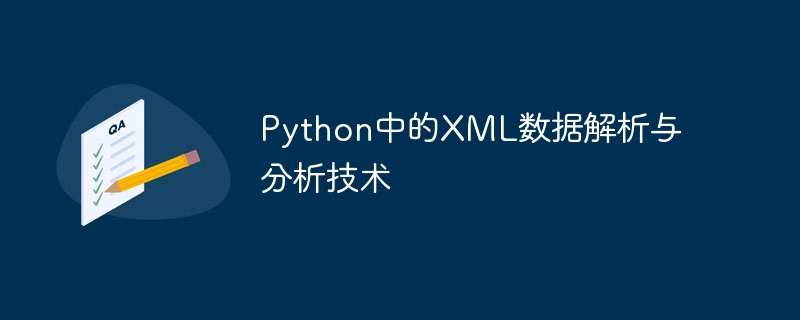

XML data parsing and analysis technology in Python
XML (Extensible Markup Language) is a markup language used to store and transmit data. XML is widely used in information interaction and data storage. Python provides a variety of libraries and modules for parsing and analyzing XML data. In this article, we'll cover how to use Python to parse and analyze XML data, and provide some code examples.
The xml.etree.ElementTree library is provided in Python’s standard library for parsing and manipulating XML data. We can use this library to traverse the XML tree, find elements, access the attributes and text content of elements, etc.
The following is a simple XML example:
<book>
<title>Python编程</title>
<author>John Doe</author>
<price>39.99</price>
</book>We can use the xml.etree.ElementTree library to parse the XML data into an Element object and obtain the corresponding information by traversing the object.
import xml.etree.ElementTree as ET
# 解析XML数据
tree = ET.parse('book.xml')
root = tree.getroot()
# 遍历XML树
for child in root:
print(child.tag, child.text)
# 获取元素属性
title = root.find('title')
print(title.get('lang'))
# 获取元素文本内容
price = root.find('price').text
print(price)The above code will output the following results:
title Python编程 author John Doe price 39.99 None
In addition to the xml.etree.ElementTree library, Python also provides Another powerful library, lxml, is implemented based on C language and has better performance. lxml provides more functions and methods, making processing XML data more convenient.
The following is an example of using the lxml library to parse XML data:
from lxml import etree
# 解析XML数据
tree = etree.parse('book.xml')
root = tree.getroot()
# 遍历XML树
for child in root:
print(child.tag, child.text)
# 获取元素属性
title = root.find('title')
print(title.get('lang'))
# 获取元素文本内容
price = root.find('price').text
print(price)This code is very similar to the previous example, but uses the lxml library. It can be found that the lxml library is simpler and more direct to use, and the code blocks are more concise.
XPath is a very useful technology when parsing and analyzing XML data. XPath provides a concise syntax for locating nodes in XML through expressions. Both Python's ElementTree and lxml libraries support XPath.
The following is an example of using XPath to parse XML data:
from lxml import etree
# 解析XML数据
tree = etree.parse('book.xml')
root = tree.getroot()
# 使用XPath定位元素
title = root.xpath('/book/title')[0]
price = root.xpath('/book/price')[0]
# 获取元素文本内容
print(title.text)
print(price.text)The above code uses the XPath expressions /book/title and /book/priceLocate the title and price elements respectively. By using the first element of the positioning result as a node, we can obtain the corresponding text content.
Through the introduction of this article, we have learned the technology of using Python to parse and analyze XML data. We learned how to use xml.etree.ElementTree and the lxml library to parse XML data and use XPath for location. After mastering these technologies, we can process XML data more easily and extract the information we need.
(Note: The above code examples are for reference only. When used in practice, please adjust and modify them according to the specific XML data structure and requirements.)
The above is the detailed content of XML data parsing and analysis technology in Python. For more information, please follow other related articles on the PHP Chinese website!




